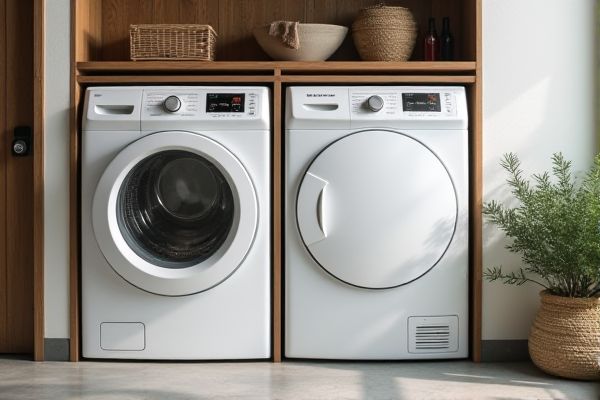
Smart dryers offer advanced features like moisture sensors, app control, and energy efficiency that traditional dryers lack, allowing you to save time and reduce utility costs. Discover how these innovations can transform your laundry routine by reading the rest of the article.
Table of Comparison
| Feature | Smart Dryer | Traditional Dryer |
|---|---|---|
| Energy Efficiency | High, uses sensors to optimize drying time | Moderate, fixed cycles without sensors |
| Drying Technology | Sensor-based moisture detection | Timed drying cycles |
| Connectivity | Wi-Fi enabled, smart home integration | No connectivity features |
| Control Interface | Mobile app and voice control | Physical buttons and dials |
| Drying Programs | Multiple custom and eco-friendly modes | Standard preset cycles |
| Maintenance Alerts | Automatic lint filter and performance alerts | Manual inspection required |
| Cost | Higher upfront price, energy savings over time | Lower initial cost, higher energy expenses |
| Lifespan | 10-15 years with smart diagnostics | 8-12 years average |
Introduction to Smart Dryers and Traditional Dryers
Smart dryers incorporate advanced sensors and connectivity features that optimize drying cycles for energy efficiency and fabric care, enabling remote control via smartphone apps. Traditional dryers rely on manual settings with basic temperature and timer controls, lacking automated moisture detection and app integration. Smart dryers often reduce drying time and energy consumption compared to traditional models, offering a modern upgrade for convenient laundry management.
Key Features of Smart Dryers
Smart dryers feature advanced sensors that optimize drying time and energy consumption by detecting moisture levels in fabrics. They include Wi-Fi connectivity for remote monitoring and control through smartphone apps, allowing customization of drying cycles and notifications. Enhanced features such as steam refresh, wrinkle prevention, and integration with smart home systems differentiate smart dryers from traditional models.
Traditional Dryer Basics
Traditional dryers operate using electric or gas heating elements to generate hot air that tumbles laundry inside a rotating drum, effectively removing moisture. These models rely on timed drying cycles without moisture sensors, often leading to either overdrying or damp clothes. Despite their straightforward operation, traditional dryers tend to consume more energy compared to smart dryers equipped with advanced sensors and optimized drying algorithms.
Energy Efficiency Comparison
Smart dryers utilize advanced sensors and algorithms to optimize drying cycles, significantly reducing energy consumption compared to traditional dryers. Traditional dryers operate on set timers and fixed heat levels, often leading to longer drying times and wasted energy. Energy Star-certified smart dryers can cut energy use by up to 30%, offering substantial savings on utility bills.
Connectivity and Smart Home Integration
Smart dryers offer advanced connectivity features, allowing you to control and monitor your laundry remotely through smartphone apps or voice assistants like Alexa and Google Assistant, enhancing convenience and efficiency. Traditional dryers lack these smart capabilities, requiring manual operation and limiting integration with other smart home devices. With a smart dryer integrated into your connected home ecosystem, you can receive real-time notifications, schedule cycles, and optimize energy usage easily.
Drying Performance and Fabric Care
Smart dryers use advanced sensors to optimize drying time and temperature, ensuring efficient moisture removal while preventing over-drying, which preserves fabric integrity and reduces wear. Traditional dryers rely on preset cycles that may cause uneven drying and potential heat damage to clothes. Enhanced fabric care in smart dryers results from adaptive technology that adjusts drying settings based on fabric type and load size, significantly extending garment lifespan.
Cost and Long-Term Savings
Smart dryers typically have higher upfront costs, ranging from $1,000 to $1,500, compared to traditional dryers priced between $400 and $700. Energy-efficient features in smart dryers, such as moisture sensors and optimized drying cycles, can reduce electricity consumption by up to 25%, leading to significant long-term savings on utility bills. Over time, reduced maintenance and improved drying efficiency make smart dryers a cost-effective investment despite their initial price premium.
User Experience and Convenience
Smart dryers offer enhanced user experience through app connectivity, allowing remote monitoring and control, customizable drying cycles, and notifications on cycle completion. Traditional dryers lack these features, often requiring manual adjustment and monitoring, which can be less convenient for multitasking households. Advanced sensors in smart dryers optimize drying time and fabric care, reducing energy consumption and improving garment longevity compared to conventional models.
Maintenance and Longevity
Smart dryers typically feature advanced sensors that reduce wear by optimizing drying cycles, leading to less frequent maintenance compared to traditional dryers. Traditional dryers often require manual cleaning of lint traps and regular inspection of heating elements to maintain efficiency and prevent breakdowns. Longevity is enhanced in smart dryers through self-diagnostic tools that alert users to potential issues early, whereas traditional dryers rely on routine physical maintenance to avoid premature failure.
Which Dryer is Best for Your Home?
Smart dryers offer advanced features such as Wi-Fi connectivity, sensor drying, and energy efficiency, making them ideal for tech-savvy households seeking convenience and reduced utility bills. Traditional dryers tend to be more affordable with simpler mechanics, suitable for users prioritizing cost-effectiveness and straightforward operation. Choosing the best dryer depends on your budget, desired features, and how much control you want over drying cycles and energy consumption.
 homyna.com
homyna.com